► Which hybrid SUV should you buy in 2023?
► CAR picks the best hybrid crossovers
► Our favourite low-tax family-friendly cars
If you’re looking to buy or lease a new family car in 2023, you’re going to want to know about the best hybrid cars. Fuel-saving, pollution-reducing hybrid technology is available in all kinds of car now, but for most families a hybrid SUV is probably close to the top of your list. Imposing, spacious – and sometimes even stylish – they’re often the most practical option if you’re moving a few people around.
With the latest slew of clever electrified technology, the best hybrid SUV can give you all the performance potential you could want, along with lower running costs than you’d associate with a regular petrol SUV. Choose a plug-in hybrid and that big 4×4 could be less polluting for short trips than the smallest supermini.
EDITOR’S PICK: CAR magazine’s panel of road testers have driven every hybrid SUV on sale in the UK, but if we had to pick just one, it’d be the Mercedes GLE. Why? Because it combines hybrid power with a diesel engine for some truly impressive economy stats, and gives you over 300bhp so you can choose between fun and thrift.
The best hybrid SUVs in 2023
BMW X5 xDrive 45e

Best if you like dynamic chassis and sharp handling
Pros: Nearly 400bhp in a luxury shell
Cons: 50-54 miles of electric range is impressive compared to the competition
- Fuel economy: 201.8-235.4mpg
- CO2: 27-32g/km
The X5’s gas-guzzling days are over. Well sort of. You can still buy high-performance versions of the SUV such as the X5 M, but a more eco-friendly version is now available. Known as the xDrive 45e, it’s a luxury SUV with serious performance, but no seven-seat option as the batteries take up too much room.
It’ll do an impressive 50-54 miles range on batteries alone, but can still push out 389bhp for a 0-62mph sprint time of 5.6sec. It’s in a similarly low tax bracket to the Mercedes GLE, but it’s even better to drive.
Ford Kuga PHEV
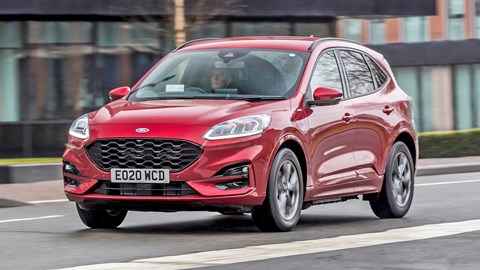
Best for value and daily use
Pros: Lots of choice, great efficiency and 35-mile EV range
Cons: Uninspiring looks and interior
- Fuel economy: 201.8mpg
- CO2: 32g/km
Ford’s third-generation Kuga SUV has several hybrid options. There’s a mild-hybrid diesel and a self-charging petrol, but it’s the plug-in version of the latter that gets our vote.
Nimble handling and plenty of flexible space will appeal to family car buyers who enjoy driving, but the 35-mile range of electric driving will appeal to the thrifty among us. Even better, it’s seriously frugal even with a flat battery, which is not a given for many plug-in hybrids.
Mercedes-Benz GLE 350de
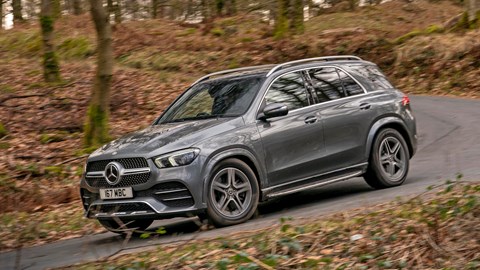
Best for super-long electric driving
Pros: 58 miles on the battery, and a diesel engine means great combined economy figures
Cons: Battery placement means you lose the possibility of seven seats
- Fuel economy: 313.9-353.1 mpg
- CO2: 20-23g/km
Mercedes’ GLE 350de features a turbocharged 2.0-litre diesel and combines it with an electric motor mounted to a nine-speed gearbox. That puts 315bhp and 516lb ft below your right foot and 0-62mph in just 6.8 seconds. In EV mode, top speed is capped to 100mph.
It’s the GLE’s astonishing electric-only range that really sets it apart, though. Thanks to a giant battery pack, official figures state it should travel up to 58 miles before the engine fires, although like all the SUVs here you’ll probably only see that around town if you’re very careful.
It has a luxurious interior that’s rammed with technology and driver aids, but like others of its ilk, no seven-seater package due to the battery location.
Land Rover Defender P400 e
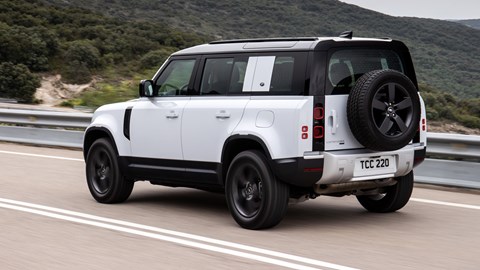
Best for the fashionista
Pros: Premium design inside and out, and it’s coupled with close to 400bhp
Cons: Lacks the theatre of the V8 version, and only has a 27-mile electric range
- Fuel economy: 85.3mpg
- CO2: 74g/km
One of the most desirable SUVs has a plug-in hybrid powertrain option. Sure, it’s in a higher benefit-in-kind company car tax band than most of the other SUVs here, but it’s still astonishingly good for something this chunky and it has impressive fuel economy and emissions figures for its size.
There’s still good performance in the P400e as it produces 398bhp, though the 2.0-litre Ingenium petrol engine and electric motor don’t have the same presence as the V8’s classic growl. If you’d rather run on volts, the official electric range is up to 27 miles.
Crucially, it retains that gorgeous interior and the star quality associated with Land Rover’s rugged model.
Porsche Cayenne Turbo S E-Hybrid
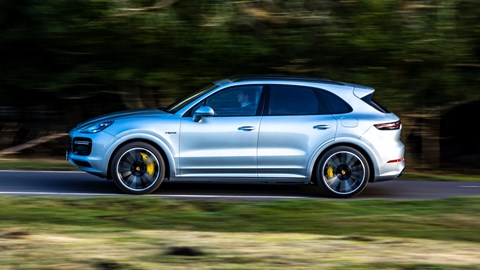
Best for hybrid SUV drivers in a rush
Pros: Ridiculously fast for a car this size: 671bhp and 0-62mph in just 3.8sec!
Cons: The regular E-Hybrid is much cheaper, and has slightly better economy and CO2 stats
- Fuel economy: 68.9-74.3mpg
- CO2: 86-92g/km
The Porsche portfolio has grown massively in recent years, and this Cayenne Turbo S E-Hybrid is a case in point. The Cayenne Turbo S E-Hybrid is marketed by Stuttgart as a sports SUV, and it does have the specs to match, as well as the alternative five-door Coupe bodystyle option. It uses a 671bhp PHEV powertrain delivering impressive performance: 0-62mph takes 3.8 seconds and a top speed of 183mph.
If that’s too much, the ‘regular’ Cayenne E-Hybrid is considerably cheaper and boasts 76.3-91.1mpg as well as CO2 emissions of 71-83g/km.
Land Rover Discovery Sport PHEV
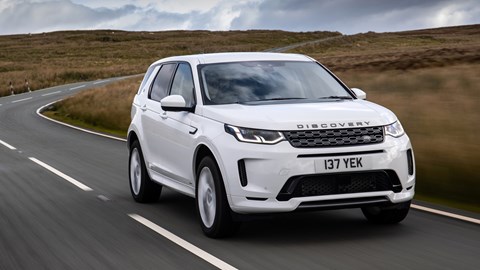
Best for those wanting parsimony with off-road creds
Pros: The cleanest model in the range retains its off-road skills. 34-mile electric range is good too
Cons: No third row of seats due to hybrid packaging requirements
- Fuel economy: 143.1mpg
- CO2: 44g/km
Despite only having a diddy 1.5-litre turbocharged three-cylinder engine driving the front wheels, the addition of a chunky electric motor for the rears gives the P300e a total of 305bhp. That makes this the quickest model in the range as well as the cleanest, while helping it retain the off-road ability you’d expect from a Land Rover.
Yes, you do lose out on the option of a third row of seats – you’ll need to scroll down for our pick of the best seven-seat hybrid SUVs – and it’s certainly not cheap to buy, but the 34-mile electric only range and sub-50g/km CO2 emissions give competitive CO2 emissions. Decent space inside and a comfortable ride make it well worth a look.
Honda CR-V Hybrid
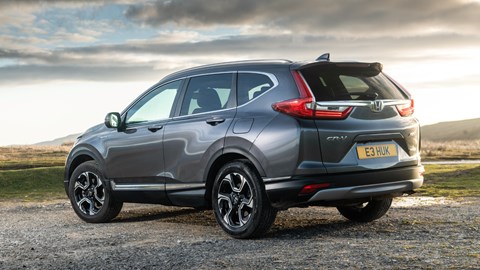
Best for buyers wanting Japanese reliability
Pros: Choice between FWD or 4WD, and the former has competitive economy stats
Cons: Good on paper, boring in real life
- Fuel economy: 42.2-42.8mpg (front-wheel drive versions)
- CO2: 151g/km (front-wheel drive versions)
The CR-V uses a 2.0-litre petrol engine along with a pair of electric motors delivering decent economy and performance. It comes with a choice of front- or all-wheel drive, with efficiency dropping to 39.2-39.8mpg and 161-163g/km of CO2 for the latter.
It’s not the most exciting SUV, but improvements such as a larger interior mean the CR-V is even better suited for family life this time around.
Audi Q7 TFSIe
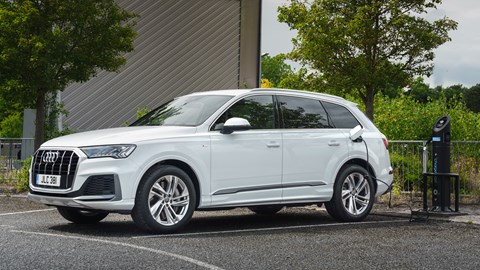
Best for drivers wanting space and Teutonic quality
Pros: Premium interior and exterior combined with a punchy 0-62mph launch of 5.9 seconds
Cons: It’s pricey and the third row of seats from the standard car goes missing here
- Fuel economy: 97.4-113.0mpg
- CO2: 57-66g/km
It’s pricey, but the Q7 TFSIe packs a lot of clever plug-in hybrid gubbins into its huge footprint: there are five seats (you lose the rearmost row in favour of batteries) and it uses active engine mounts to further refine its 3.0-litre petrol power. Previously, the Q7 plug-in hybrid wore e-Tron badges and featured a diesel motor.
Audi quotes 0-62mph in 5.9sec and as low as 57g/km of CO2 for the 55 TFSI e (an even punchier but thirstier 60 TFSI e is also available), so it’s quick and impressively parsimonious. On paper at least. That big battery needs two-and-a-half hours to charge on a fast charge – and more like eight on a three-point plug at home – so make sure you have the correct charging facilities.
Toyota C-HR Hybrid
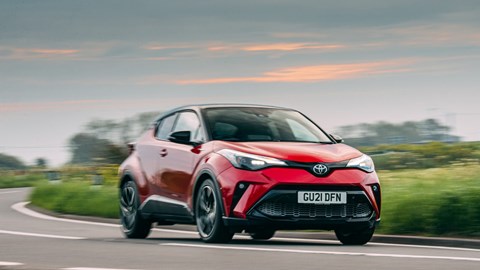
Best for fans of quirky small crossovers
Pros: Shoehorns the Prius powertrain into a relatively interesting bodyshell
Cons: A sensible choice, but there are better cars on this list
- Fuel economy: 53.2-57.6mpg
- CO2: 110-120g/km
The C-HR packs the Prius’s hybrid powertrain into a more zeitgeisty crossover bodyshell. It’s far from a dull old Toyota, with interesting styling inside and out, plus the lure of impressive efficiency. It’s about to be replaced and you can read more about the new Toyota C-HR here.
Originally a petrol-only CH-R was available, but now it’s exclusively self-charging hybrids. There’s an economy-minded 1.8-litre with 120bhp, but the brawnier 2.0-litre packs a 181bhp punch for easier overtakes and more B-road fun.
Volvo XC40 Recharge
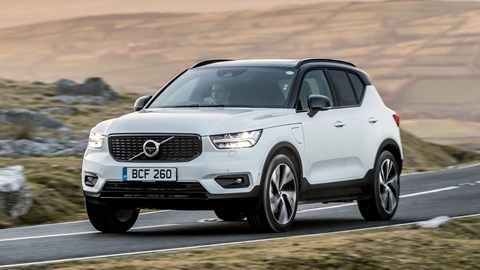
Best for a lovely calm, Swedish interior
Pros: Luxury interior, impressive safety stats and no impact on boot space for the hybrid version
Cons: Higher tax bracket than rivals
- Fuel economy: 117.7-134.5mpg (T4 & T5)
- CO2: 47-55g/km (T4 & T5)
Volvo used to be known for its class-leading estates, but now the brand is equally known for its impressive SUVs with the XC40 Recharge a great example. Not only does it have an attractive exterior and a plush interior, there’s no impact on boot space unlike the vast majority of plug-in hybrids.
Two versions of the XC40 Recharge are available. The T4 packs 208bhp and has a 0-62mph time of 8.5sec, while the T5 has 258bhp and can squirt from 0-62mph in 7.3sec. Both are front-wheel drive and have a maximum electric-only range of 28 miles. That puts them in a higher tax bracket than most rivals, yet it’s still well below a petrol-powered equivalent. Being a Volvo, they’re full of the latest safety kit, too, including an electronically capped top speed of 112mph.
Kia Sorento
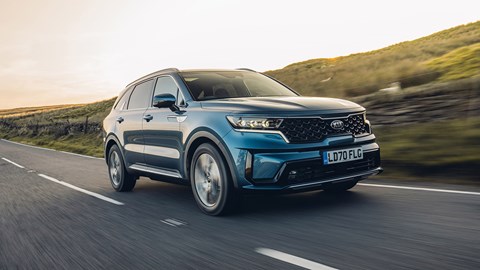
Best for value vs space
Pros: Seven seats remain an option on the hybrid car
Cons: Not massively exciting
- Fuel economy: 38.2-176.6mpg
- CO2: 158-38g/km
The Kia Sorento is closely related to the Hyundai Santa Fe, but proves a bit more spacious and has a cheaper starting price. Like the Hyundai, it’s powered by a 1.6-litre turbocharged petrol engine with either a normal or plug-in hybrid system.
Unlike the Hyundai, all models are four-wheel drive which does push CO2 up slightly. Seven seats come as standard on all models.
Kia Sorento review
Kia Sorento lease Deals VIEW OFFER
Volvo XC90 Recharge
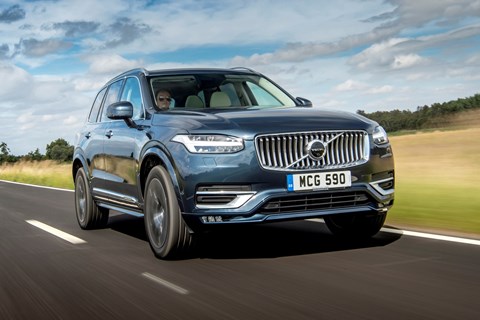
Best for those wanting to mix seven seats and hybrid tech
Pros: Seven seats combined with a premium interior and 385bhp. It’ll launch from 0-62mph in 5.5 seconds
Cons: Looking a little tired now, and has a poor CO2 and fuel economy stats
- Fuel economy: 83.1-100.9mpg
- CO2: 63-76g/km
Even after a good few years on sale, the XC90 is still the only plug-in hybrid SUV to combine a premium badge and luxurious interior with seven seat versatility. With the third row folded away, there’s a vast amount of boot space, too.
It also has a mighty 385bhp under the bonnet to give 0-62mph in just 5.5sec. This does make up for the relatively poor electric-only range and CO2 emissions higher than many five-seat rivals.
Volvo XC90 review
Volvo XC90 lease Deals VIEW OFFER
Hyundai Santa Fe PHEV
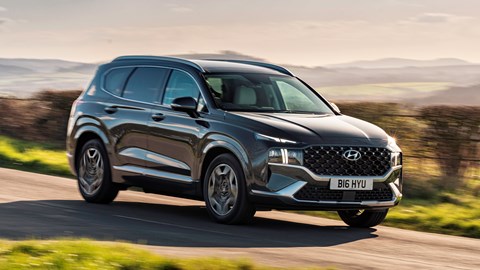
Best for drivers wanting space on a budget
Pros: Seven seats as standard, five and seven seat options available
Cons: Performance isn’t as competitive as some, and looks aren’t for everyone
- Fuel economy: 40.4-173.7mpg
- CO2: 37-159g/km
Regardless of whether you go for the regular hybrid or plug-in, the Santa Fe comes with seven usable seats as standard. The former gives you the option of front or four-wheel drive while the latter comes with four-wheel drive only.
The Santa Fe only comes in two very well equipped trims and although performance isn’t particularly strong, we saw an easy 40mpg out of the regular hybrid. Given that the plug-in is capable of over 30 miles of electric-only running according to official figures, fuel stops will be an infrequent thing if you’re able to top the battery up regularly.
Why a hybrid car?
Hybrids represent an increasingly popular stepping stone between the best electric cars and the best petrol ones. Boasting many of the benefits of a BEV (Battery Electric Vehicle), hybrid SUVs can deliver inexpensive and silent running in town, but without the range restrictions of an electric-only alternative. That makes them great for skating around to the shops, or for longer hauls such as staycations or road trips.
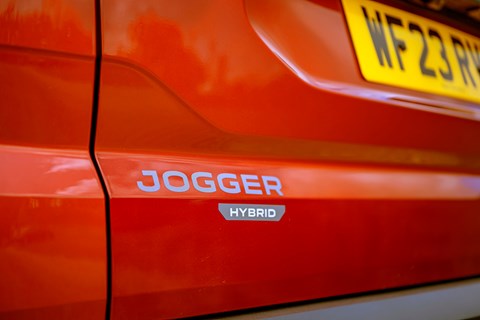
Hybridisation brings other benefits, too: some hybrid SUVs deliver cheaper running costs than their ICE-only counterparts, while the fastest hybrid cars use their electric power specifically for a boost in performance. We’ve added a mixture of the two in our list of best hybrids above.
If you’ve got a family, we’d recommend looking specifically at our guides to the best family hybrid cars and the best hybrid estate cars.
We also have a handy guide explaining the pros and cons of owning a hybrid car.
What’s the best small hybrid SUV on sale in 2023?
Hybrid SUVs combine incredible practicality with low running costs – but what if you don’t need the space? Hybrid cars come in all shapes and sizes now, and that means there’s also a huge range of smaller hybrid cars to choose from in 2023. From the Toyota Yaris Hybrid to the Mini Countryman PHEV, there are several impressive machines on the market today, and to make things easier we’ve rounded up the best ones in our best small hybrid car guide.
What’s the biggest hybrid SUV?
If a normal hybrid SUV doesn’t offer enough space, it’s worth checking our guide to the best seven-seater hybrid cars.

How to make the most of driving a hybrid SUV
Now you’ve seen the best hybrid SUVs, it’s worth considering how you drive and what your family and work demands are. They all have lower CO2 than their petrol or diesel equivalents, so for company car drivers the benefit-in-kind is much lower, and they will be better placed for future emission-based taxation or restrictions on town and city centre driving.
In real terms, however, many of them are much closer in fuel economy to the petrol version if you use them for longer drives and don’t plug them in often. Here are some of the things we’ve learned while testing hybrid SUVs.
- If you do school runs, shopping trips and commuting that’s just a few miles, the hybrid SUV will be much kinder to the environment. Cars with petrol or diesel engines produce the worst emissions when cold and queuing in traffic, particularly if there’s a lot of acceleration and braking. The electric motor in a hybrid is perfectly suited for these conditions – as long as you always charge the battery overnight.
- If your hybrid SUV can be scheduled to pre-condition in winter or summer while it’s plugged in, make use of that feature. Particularly in winter, your battery will go much further if the car has warmed up and defrosted using mains power before you need it. It’s more convenient than scraping ice from windows in the bitter cold, too.
- For long journeys, take advantage of congested bottlenecks and 40-50mph traffic to use ‘charge mode’ and top the battery up (if the car supports it). It’s the time when you’ll notice the least impact on consumption.
- If you do longer journeys, say over 20 miles, daily and can’t plug in at your destination, a self-charging hybrid will give you better running costs.
- If you plug in regularly for lots of short trips, then suddenly need to do a long journey, don’t forget the car will need petrol…
Given the popularity of larger, heavier cars for routine driving in the 21st century, the hybrid SUV is probably the best solution for most families now, with the potential to have the biggest impact on emissions if used correctly. If an electric car isn’t for you but you want to be ‘greener’, this is the next best thing.
What is a hybrid car?